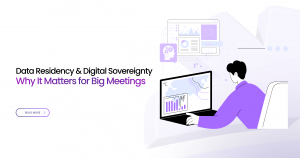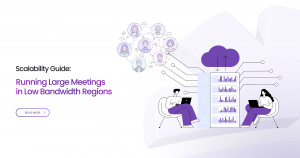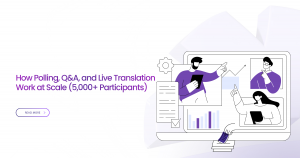Introduction
When leaders meet online, the conversation is more than talk. It becomes data—audio, video, chat, transcripts, and minutes. In 2025, many organizations must keep that data under local law. This idea is called data sovereignty. If you work in government, defense, finance, healthcare, or higher education, understanding sovereignty is not optional. It’s how you protect your people, your mission, and your legal duties.
This guide explains data sovereignty vs data residency, why it matters for video meetings, the security standards you should demand, and how to deploy a sovereign-ready platform step by step. You’ll also see why Convay is built for these requirements.
Data sovereignty vs data residency (simple definitions)
Data sovereignty is about who has legal control over data. It says that data is subject to the laws of the country where it is stored or processed. Data residency is about where the data physically lives—which country, region, or data center. In practice, they work together: location drives the law that applies to your data. IBM+1
For example, EU GDPR limits transfers of personal data outside the EU unless proper safeguards or adequacy decisions exist. That means choosing where your video records and transcripts live is a legal issue, not just a technical one. European Commission+1
There is another angle: some laws can reach across borders. The U.S. CLOUD Act allows U.S. orders to compel service providers to produce certain data in their possession, custody, or control, even if the data is stored overseas. This is one reason many public bodies prefer sovereign or on-prem options. Congress.gov+1
Why sovereignty matters in video meetings
Online meetings create several kinds of sensitive data:
- Live media: the audio and video streams.
- Metadata: join times, participant IDs, IP addresses, device details.
- Artifacts: recordings, transcripts, meeting minutes, chat logs, and shared files.
If these live in the wrong place—or under a law that conflicts with your policy—you may face investigation delays, blocked transfers, or legal exposure. Sovereignty gives you predictability: you decide where data sits, who can access it, and which courts and regulators have authority. European Commission
The security baseline for sovereign video conferencing
Sovereignty is not only location; it’s also control and protection. Best-practice platforms enforce modern standards:
- Media encryption in transit: DTLS-SRTP for WebRTC audio/video; TLS 1.3 for signaling, APIs, chat, and file transfer. IETF Datatracker+2IETF Datatracker+2
- Encryption at rest: AES-256 with strong key management; audit logs for access and changes.
- Identity & access: SSO/MFA, role-based access control, lobby/waiting rooms, meeting passwords, domain/country locks.
- Governance controls: retention policies, DLP, watermarking, immutable audit trails.
Convay’s security documentation lists these measures across conferencing, chat, and file storage, including DTLS-SRTP, TLS 1.3, AES-256-GCM, SSO/MFA, key-management options (HSM/KMS), DLP, link expiry, password-protected sharing, and audit trails.
Residency choices: cloud, hybrid, on-prem, sovereign cloud
A sovereignty-ready platform should let you pick where data lives:
- Public cloud (regional): choose a region with the laws you accept.
- Hybrid: store artifacts (recordings, transcripts, minutes, files) in-country, even if other services run in the cloud.
- On-prem: keep everything on servers you operate.
- Sovereign/national cloud: hosted by an in-country provider with strict legal controls.
Convay supports cloud, hybrid, and on-prem deployments and is designed for digital sovereignty so governments and regulated enterprises can keep data in-country under local jurisdiction.
What counts as “meeting data” for compliance?
Beyond recordings, regulators focus on personal data and confidential content inside:
- Transcripts and Minutes: who said what, decisions, action items. Convay treats transcripts and meeting minutes as encrypted structured data with restricted access.
- Chat & Files: messages, links, attachments. Convay supports E2EE chats, file access policies, link expiry, password-enforced sharing, and virus scanning.
- Metadata: attendance, timestamps, device info—should be encrypted and logged with access trails. Convay documents encrypted logging and audit.
How to evaluate a vendor for sovereignty (7 steps)
- Map your laws. Identify all rules that apply (e.g., GDPR international transfer rules; UK ICO guidance for restricted transfers). List any localization or residency mandates. European Commission+1
- Pick the hosting model. If you need tight control, start with on-prem or sovereign cloud. Confirm the country and operator.
- Check transport security. Require DTLS-SRTP for media and TLS 1.3 for signaling/APIs. Ask for formal documentation. IETF Datatracker
- Check encryption at rest. Look for AES-256-GCM, per-file keys, and supported KMS/HSM options.
- Identity and meeting controls. Enforce SSO/MFA, lobby/waiting rooms, meeting passwords, domain/country locks, and “logged-in users only.” Convay lists these controls in its meeting operations.
- Governance & DLP. Confirm audit trails, link expiry, password-protected sharing, WORM mode for files, and retention. Convay documents immutable audit, DLP, view-only links, and retention.
- Transcripts & minutes. Verify export formats (PDF/TXT/DOCX), Bangla/English support if needed, and controls on who can access or edit. Convay’s user manual shows real-time transcription, speaker names, denoise, and export paths.
Convay: sovereignty by design (what the docs say)
Convay is a secure, enterprise-grade collaboration platform that integrates real-time video, decentralized secure chat, and encrypted file sharing. It is architected for compliance and deployment flexibility across cloud and on-prem environments.
Encryption and transport
- Media: DTLS-SRTP protects voice/video streams.
- APIs/Signaling: TLS 1.3/HTTPS/WSS.
- Files: AES-256-GCM at rest, per-file keys; KMS/HSM support.
- Chats: E2EE with Olm/Megolm; forward secrecy; device verification.
These are spelled out in Convay’s security papers.
Meeting operations and governance
Convay includes country/domain locks, random meeting IDs, waiting rooms, and “logged-in users only.” Artifacts—recordings, transcripts, minutes—are encrypted, and admins can enforce audit, DLP, link expiry, and password-enforced sharing for files.
Transcription & minutes (Bangla + English)
Convay provides real-time transcription with speaker identification, noise reduction, and exports to PDF/TXT/DOCX for filing or case work. This is useful for public meetings, board reviews, and compliance audits.
How sovereignty changes your deployment plan (a short playbook)
Step 1 — Classify meetings. Split into public, internal-confidential, and sensitive/regulated. Sensitive meetings require on-prem/sovereign hosting and strict controls.
Step 2 — Choose residency. Keep recordings, transcripts, minutes, and logs in-country. If you must use cloud features, store artifacts locally.
Step 3 — Identity and access. Enforce SSO/MFA for all hosts. Require lobby and passwords for sensitive rooms. Limit recording privileges to specific roles.
Step 4 — Retention & audit. Define how long to keep artifacts. Enable immutable audit trails and DLP. Review sharing links monthly.
Step 5 — Transcripts & minutes. Standardize the export format (PDF/DOCX/TXT). Train hosts to do a two-minute review after each meeting, fix names/dates, and file the minutes.
Step 6 — Test the edge cases. Low bandwidth? Convay is tuned for HD in tough networks and supports large meetings natively, which helps national events and hearings.
Risks if you ignore sovereignty
- Cross-border transfers without proper safeguards can fail compliance tests (GDPR/UK GDPR). European Commission+1
- Third-country access could apply via local laws like the CLOUD Act, depending on provider control. Congress.gov
- Breach fallout gets worse if logs and artifacts aren’t encrypted and audited. (CISA guidance emphasizes secure settings and hygiene for video tools.) CISA
Frequently asked questions
Is “EU region” hosting enough for GDPR?
Not by itself. You must also manage international transfer rules and safeguards. Region choice helps, but you still need contracts and controls. European Commission
Do I need on-prem to be sovereign?
Not always. Some national clouds or local providers qualify. On-prem gives maximum control. Convay supports on-prem, hybrid, and sovereign options.
What about meeting transcripts?
Treat them as sensitive records. Convay encrypts transcripts and meeting minutes and lets you export in standard formats for filing.
What technical acronyms should I check in RFPs?
DTLS-SRTP, TLS 1.3, AES-256 at rest, SSO/MFA, RBAC, audit, DLP, KMS/HSM, and country/domain locks. Convay documents these controls.
Conclusion
Data sovereignty is how you keep control of who can access your meeting data and which laws apply. It starts with where your data lives, but it also demands strong encryption, identity, and governance. In practice, that means choosing a platform that supports on-prem or sovereign hosting, modern security (DTLS-SRTP, TLS 1.3, AES-256), and admin tools for retention, DLP, and audits.
Convay was built for this world. It brings secure video, encrypted chat, file storage, and AI transcripts/minutes together, with on-prem/hybrid/sovereign deployment and the controls your auditors expect. For governments, universities, and regulated enterprises, that is the difference between hope and compliance you can prove.


